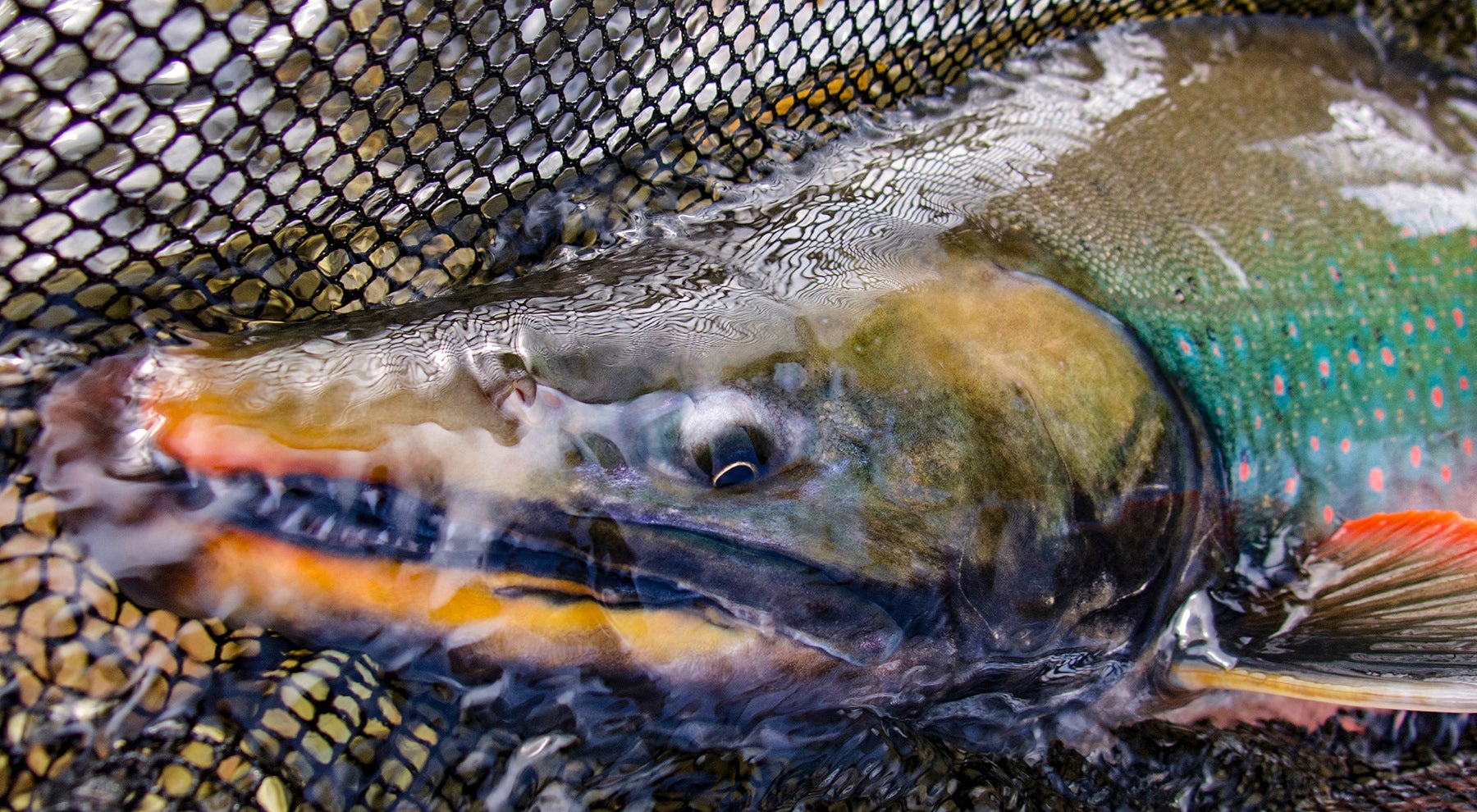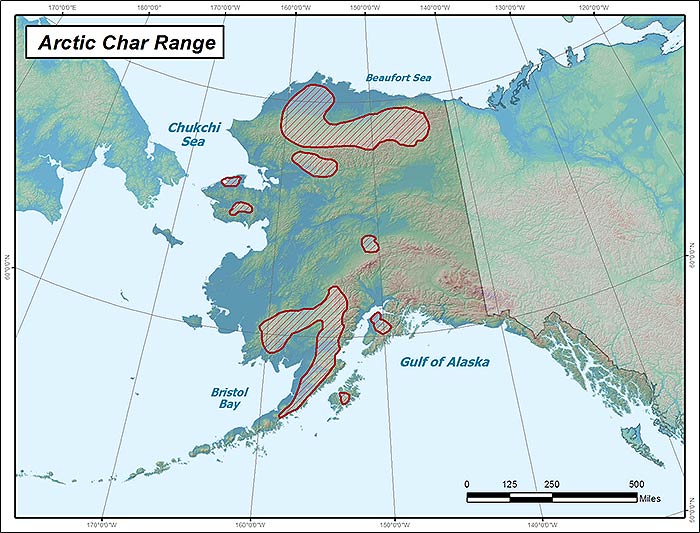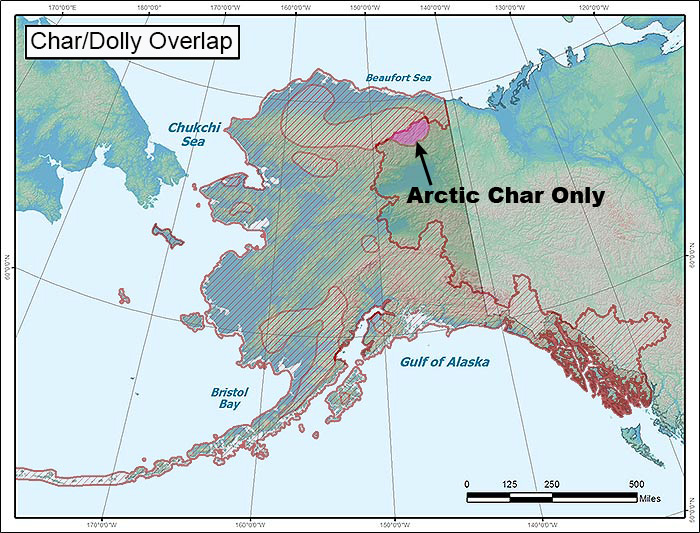Arctic char (Salvelinus alpinas) are the stuff dreams are made of. Large, aggressive, and beautiful in their spawning colors, Arctic char are the kings of their domain. It's possible some years to fly over portions of the Arctic and observe entire portions of the river that are black with char.

Biology
Alaska has four species of char; lake trout, brook trout, Arctic char, and Dolly Varden. Char are distinguished from trout by the presentation of spots on their body. Simply put, char have light spots on a dark body, and trout have dark spots on a lighter body. Arctic char are difficult to distinguish from Dolly Varden in the field, however, the Arctic char generally has fewer spots, a deeply-forked tail in contrast to the Dolly's shallower fork, and a narrower caudal peduncle (the base of the tail.) In their spawning colors, Arctic char present bright orange bellies, large cream-colored to orange spots, and fins trimmed in orange, black, and white. Perhaps one of the best ways to tell Dollies and Arctic char apart from one another is the fact that Arctic char are lake dwellers. So if you catch a fish in a river that you think is an Arctic char, it's actually a Dolly Varden.
There are two varieties of Arctic char in Alaska; the "dwarf" variety, and a larger fish that may grow to sizes in excess of 10 pounds. Dwarf and regular-sized varieties can be found throughout their range. All known varieties of Arctic char in Alaska are found in lakes only.
Spawning takes place in August and October, with pre-spawners congregating around lake inlets and outlets before moving to deeper water to spawn.
Arctic char feed on zooplankton, insects, and smaller fish.
Distribution

(ADFG map)
Arctic char are found in lakes across the Arctic region, the Kigluaik Mountains on the Seward Peninsula, the Kuskokwim Mountain Range between McGrath and Bethel, lakes on the upper part of the Alaska Peninsula, and Kodiak Island.

(from ADFG map)
It's impossible to talk about Arctic char without mentioning Dolly Varden. That's because their similar coloration and their overlapping ranges have anglers mistaking one for the other. For this reason, the Alaska Department of Fish and Game merges the bag limit as "Arctic char/Dolly Varden" without separating the two species. The above map shows the areas of overlap between Dolly and Arctic char ranges, with the one area in northeast Alaska that has Arctic char only.
ADFG Stocking Program
Additionally, the Alaska Department of Fish and Game stocks sterile Arctic char for anglers to catch. These fish are stocked in the following lakes:
Anchorage
- Campbell Point Lake
- Clunie Lake
- Fish Lake (Elmendorf)
- Green Lake (Anchorage)
- Sand Lake (Anchorage)
- Thompson Lake (Anchorage)
Matanuska-Susitna Valley
- Carpenter Lake
- Echo Lake (Kepler-Bradley)
- Finger Lake
- Irene Lake
- Kepler/Bradley Lake
- Long Lake (Glenn Highway)
- Lynne Lake
- Marion Lake
- Matanuska Lake
- Memory Lake
- Prator Lake
- Rush Lake
- Seventeenmile Lake
Kenai Peninsula
- Carter Lake
- Elephant Lake
- Island Lake (Kenai)
- Upper Summit Lake
- Vagt Lake
Fairbanks
- Birch Lake
- Chena Lake
- Harding Lake
- Lost Lake
Glennallen
- Buffalo Lake
- Dick Lake
- Ryan Lake
- Tex Smith Lake
- Two Mile Lake (Chitina)
Tactics
Arctic char are at their most vulnerable to anglers when they're in shallow water. In western Alaska, they gather in river outlet areas to feed on out-migrating salmon smolts during late May through early July. They then scatter into the lakes, and don't move into shallow water in any numbers until pre-spawning in August and October. Concentrate your efforts around river inlet and outlet areas, using baitfish imitations and attractor patterns primarily.
Fly-Fishing for Arctic Char
A floating line is ideal in shallow water, but a sink-tip can get your offering deeper. If you're using a floating line, consider adding a few weighted streamer flies to your box. Leader length can vary from seven to nine feet or so and should be anywhere from 4lb. to 8lb. (1x-5x or so.) Use attractors, or streamers designed to look like baitfish. Streamer fly sizes should range from 2-6. You can catch Dollies on dry flies in shallow water, particularly in the early or late hours when fish will be feeding in the shallows or near shoreline. In that case, you should switch out to a floating line and a lighter tippet.
| Tippet Diameter | Tippet Size | Pound Test | Fly Size |
| .003 | 8x | 1.2 | 24, 26, 28 |
| .004 | 7x | 2 | 20, 22, 24, 26 |
| .005 | 6x | 3 | 16, 18,20,22 |
| .006 | 5x | 4 | 14, 16, 18 |
| .007 | 4x | 5 | 12, 14, 16 |
| .008 | 3x | 6 | 10, 12, 14 |
| .009 | 2x | 7 | 6, 8, 10 |
| .010 | 1x | 8.5 | 2, 4, 6 |
| .011 | 0x | 10 | 1/0, 2, 4 |
| .012 | x1 | 12 | 2/0, 1/0, 2 |
| .013 | x2 | 14 | 3/0, 2/0, 1/0, 2 |
| .014 | x3 | 16 | 5/0, 4/0, 3/0, 2/0 |
| .015 | x4 | 18 | 6/0, 5/0, 4/0, 3/0 |
Fly-fishermen’s Arctic Char Tacklebox
- 4-5 wt. fast-tip rod, 8’-9’ length
- Orvis Clearwater Reel
- Rio Creek sink tip line
- Tippet: 1x-5x
- Tacky Original fly box (streamers, nymphs, wet flies)
- Aventik Waterproof fly box (dry flies)
- Dry flies: Elk Hair Caddis, adams, black gnat, yellow sally, clark’s stone, stimulator
- Nymphs: Prince, bead-head prince, teeny nymph, hare’s ear, chubby chernobyl,
- Baitfish imitations: Wooly bugger, Clouser minnow, muddler minnow, alevin, zonker, gray ghost
- Attractors: Polar shrimp, popsicle, mickey finn,
Spin-Fishing for Arctic Char
Go with medium-weight tackle and fish the shallows near river inlets or outlets where salmon smolts congregate. Fish spinners or spoons. In the early morning or late evening when the sun is off the water, fish may move into shoreline areas to feed on emerging insects or terrestrials. Consider going with barbless hooks to minimize damage to fish you intend to release.
Spin-Fisherman’s Arctic Char Tacklebox
- Okuma Voyager Spinning combo kit
- Line: 4#-6#
- Spinners: Mepps black fury, Mepps Agilia, Panther Martin Classic, Vibrax, Rooster Tail
- Spoons: Kastmaster, Little Cleo, Acme Phoebe, Swedish Pimple
- Plugs: Rapala X-Rap in green.
- Swivels
- Water Gremlin Splitshot
- Sling fishing tackle bag
- Plastic tackle compartment boxes
Additional Resources
- Alaska Fishing, by Gunnar Pedersen and Rene Limeres
- The Fly-Fisher’s Guide to Alaska, by Scott Haugen





















